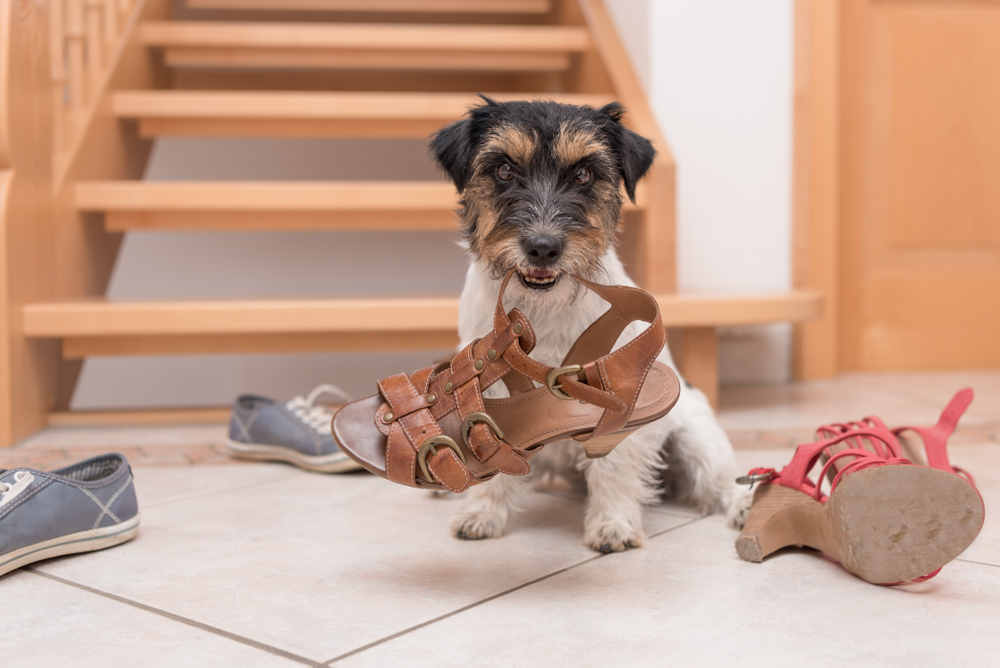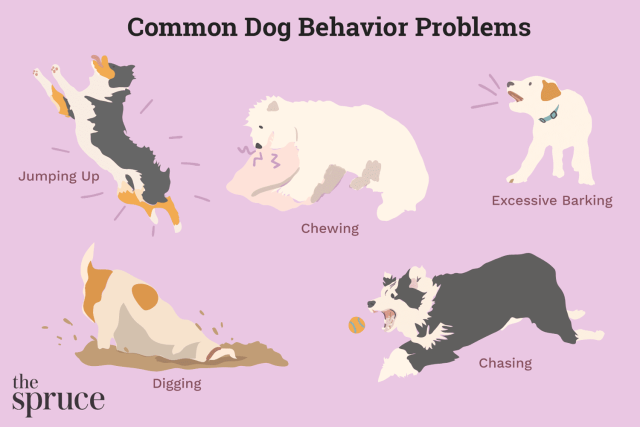To deal with dog behavior problems, identify the root cause and use positive reinforcement techniques. Consistency and patience are key.
Dog behavior problems can be frustrating, but understanding their root causes can help. Dogs may act out due to boredom, anxiety, or lack of proper training. Positive reinforcement, like treats and praise, encourages good behavior. Consistency in commands and routines creates a stable environment for your pet.
Addressing issues early prevents them from becoming ingrained habits. Professional trainers offer valuable guidance if problems persist. Remember, every dog is unique, so tailor your approach to their specific needs. Effective communication and patience build a strong bond, promoting a well-behaved dog.
:strip_icc()/common-dog-behavior-problems-1118278-10-469931e220c7452f89b458b8db0bd62d.jpg)
Credit: www.thesprucepets.com
Common Dog Behavior Issues
Dogs bark for many reasons. They may be bored, excited, or anxious. Some dogs bark to get attention or alert you to something. Understanding the cause helps you address the issue. Training and socialization can reduce excessive barking. Providing toys and exercise can also help.
Chewing is natural for dogs. They chew to explore the world and keep their teeth healthy. Puppies chew because they are teething. Provide safe chew toys to satisfy this need. Remove items you don’t want chewed. Training and supervision are key to stop unwanted chewing.
Dogs dig for many reasons. They may be bored, hot, or hunting for small animals. Some dogs dig to create a comfortable spot to rest. Give your dog plenty of exercise and mental stimulation. Designate a digging area if possible. Training and redirecting the behavior helps too.
Understanding The Root Causes
Genetic factors play a big role in dog behavior. Some dogs are naturally more active. Others may be more relaxed and calm. These traits come from their parents. Knowing a dog’s breed can help understand its behavior. For example, herding breeds often have high energy. They need lots of exercise and mental tasks. Understanding genetics helps in managing dog behavior better.
Environment also shapes a dog’s behavior. Dogs living in noisy places may become anxious. Calm and quiet homes make dogs feel safe. Social interactions are important too. Dogs need to meet other dogs and people. Positive experiences make them friendly. Negative experiences can make them scared. Keeping a dog’s environment stable helps in reducing bad behaviors.
Training Techniques
Address dog behavior problems effectively with positive reinforcement and consistency. Reward good behavior and establish clear boundaries to create a well-behaved pet.
Positive Reinforcement
Positive reinforcement is a great way to train dogs. It means giving treats or praise when dogs do something good. Dogs love rewards. This method helps them learn quickly. Always give rewards right after good behavior. This way, dogs understand what they did right. Do not punish bad behavior. Focus on rewarding the good. Over time, dogs will repeat good actions to get rewards.
Consistency
Consistency is key in dog training. Always use the same commands. This helps dogs understand what you want. Make sure everyone in the family uses the same commands. This avoids confusion. Stick to a routine. Feed, walk, and train your dog at the same times each day. This helps dogs feel secure. Consistent training leads to better behavior. It builds trust between you and your dog.
Behavioral Modification Tools
Crates and kennels can help manage dog behavior. They provide a safe space. Dogs feel secure in them. Crate training helps with potty training. It prevents destructive behavior. Dogs learn to relax in their crate. Always make the crate comfortable. Use soft bedding and toys. Never use the crate as punishment.
Leashes and harnesses are essential tools. They help control your dog. Proper leash training is crucial. It prevents pulling and lunging. Harnesses can reduce strain on a dog’s neck. They distribute pressure evenly. Use a no-pull harness for strong pullers. Always ensure the fit is correct. Check for comfort and security.
Socialization Strategies
Puppy classes are great for young dogs. They learn to interact with others. Social skills improve quickly. Trainers guide the process. Puppies become more confident. They learn to obey commands. Meeting other puppies is fun for them. Classes also teach owners how to handle issues. Friendly environments make learning easy. Everyone benefits from structured training.
Dog parks are perfect for socializing. Dogs play and make new friends. They get much-needed exercise. Owners can relax while dogs play. Parks offer a safe space. Supervised playtime reduces bad behavior. Dogs learn to share and interact. Regular visits help with social skills. Friendly dogs encourage positive behavior. The park is a fun place for dogs.

Credit: www.aspca.org
Dealing With Aggression
Dogs may growl, bark loudly, or show their teeth. Some dogs might snap or bite. Their fur may stand up. Their ears could be pinned back. They might stare intensely. Watch for a stiff body posture. A wagging tail can also be a sign. Aggressive dogs may lunge forward. They could try to dominate other dogs. They may guard their food or toys.
Stay calm and use a soft voice. Avoid direct eye contact with the dog. Never run from an aggressive dog. Keep your hands away from the dog’s mouth. Use treats to distract the dog. Walk away slowly if the dog is calm. Always have a leash ready. Teach your dog basic commands. Reward good behavior immediately. Consult a professional trainer for help.
Separation Anxiety Solutions
Dogs need a safe space to feel secure. A crate or a specific room can help. Make sure the area has familiar toys and a cozy bed. This space should be away from loud noises. Leave some of your clothes with your scent in the area. This helps the dog feel you are near.
Start by leaving your dog alone for short periods. Gradually increase the time you are away. Always stay calm when leaving and returning home. Do not make a big fuss. Reward your dog with treats and praise for staying calm. This helps your dog learn that being alone is okay.
Professional Help
Veterinary behaviorists are experts in pet behavior. They help solve serious dog behavior issues. A veterinary behaviorist can diagnose medical problems that affect behavior. They provide treatment plans. These plans often include training and medication. They work closely with your vet. This ensures your dog gets the best care.
Certified trainers teach dogs good manners. They use positive reinforcement. This means giving rewards for good behavior. Certified trainers can help with basic commands. They also address specific problems like barking or jumping. These trainers have proper education. They know how to handle different dog breeds. Working with a certified trainer can make your dog happier and better behaved.
Maintaining A Balanced Routine
Dogs need regular exercise to stay happy. A daily walk helps burn off energy. Playing fetch is also great. It keeps them active and healthy. Running in a safe area is fun for them too. Exercise helps avoid behavior problems. It makes them tired and calm. A tired dog is less likely to misbehave.
Mental stimulation is just as important. Puzzle toys can keep dogs busy. Training sessions are good for their brains. Learning new tricks makes them think. Hide treats around the house for a fun game. Interactive toys are also great. Keeping their mind active helps prevent boredom. A busy mind leads to a happy dog.

Credit: www.ovrs.com
Conclusion
Addressing dog behavior problems requires patience and consistency. Implement positive reinforcement and maintain a calm environment. Consult a professional if needed. By understanding your dog’s needs, you can foster a happier, well-behaved pet. Stay committed to improving your dog’s behavior for a stronger bond and a harmonious home.









